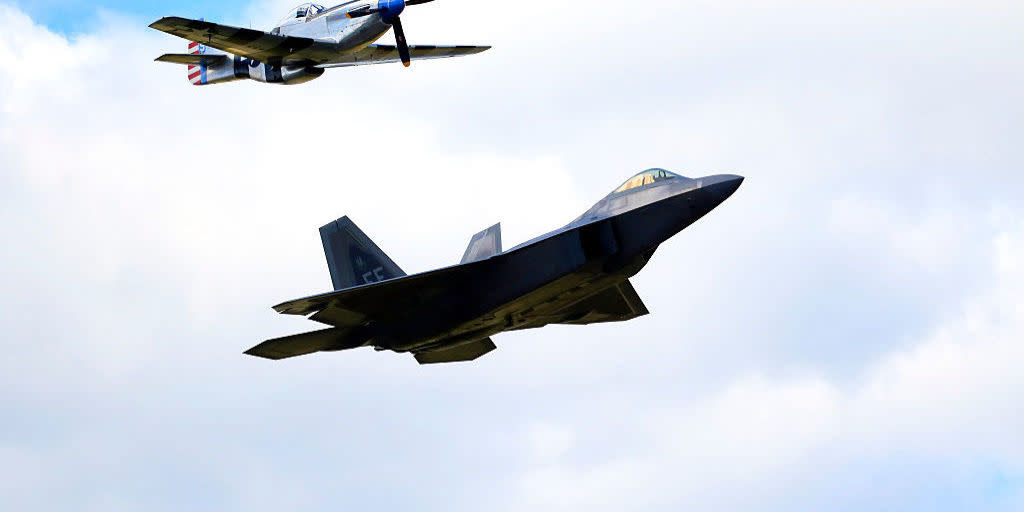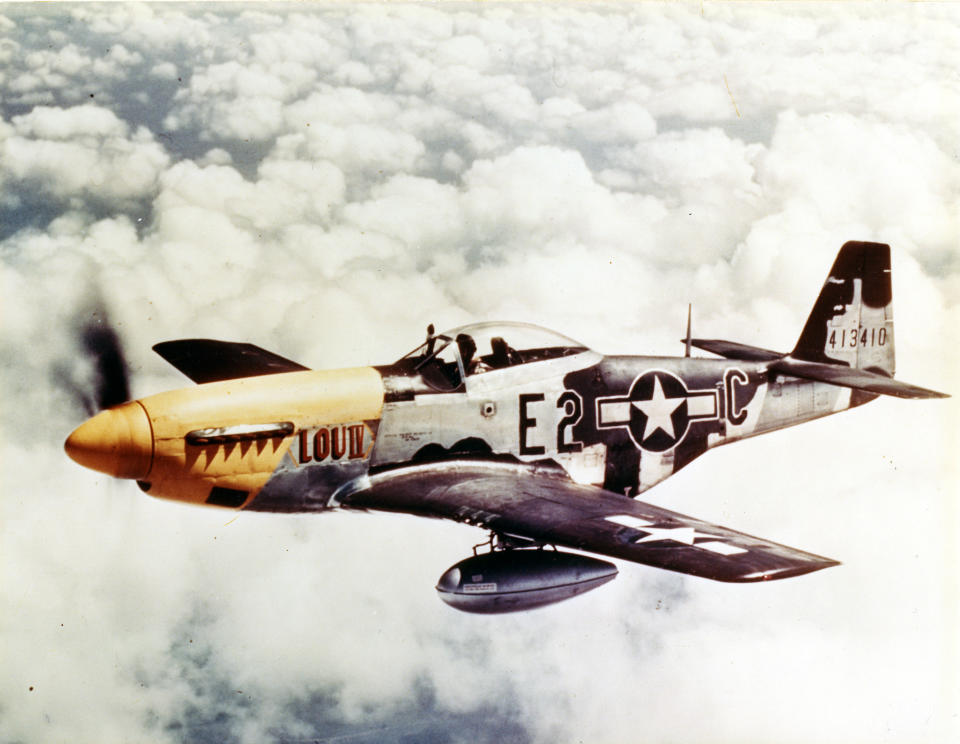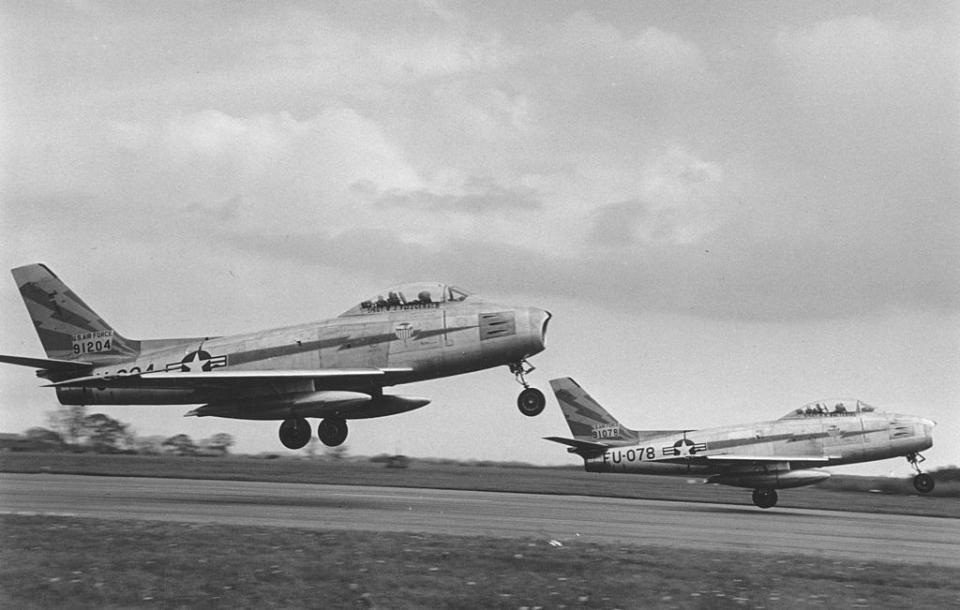5 Fighters That Show the History of the U.S. Air Force

Today is the 70th anniversary of the founding of the United States Air Force. The service, which was originally established as part of the United States Army, won its independence after helping to secure victory in World War II. As part of the commemoration, we're taking a look at five of the most iconic fighters ever to fly with the USAF and its predecessors-the Army Air Services and Army Air Forces-how each brought new tech to the skies, and how they helped pave the way for today's Air Force, the most powerful air force in the world.
Spad S.XIII

The American entry into World War I in April, 1917 saw the U.S. defense industry unprepared to support the American Expeditionary Force on the European battlefield. Three years into the war, the United Kingdom, France, Austria-Hungary, Germany, and the other major powers all had assembly lines cranking out the latest weapons, particularly the newly invented army tank and fighter plane. The U.S., on the other hand, had nothing, and was forced to buy European designs.
The SPAD S.XIII was produced by the French Société Pour L'Aviation et ses Dérivés, or SPAD for short, for the fledgling U.S. Army Air Services. Twenty feet long and 27 feet wide, the S.XIII was powered by a Hispano-Suiza 8A V8 engine that gave it 150 horsepower. This propelled the plane to a speedy 135 miles an hour and a maximum altitude of 6,560 feet. The fighter had a single pilot, who operated two M1917 .30 caliber machine guns synchronized to fire through the airplane's propellers. The airplane had a range of 171 miles and weighed 1,806 pounds fully loaded.
P-51D Mustang

The U.S. entered World War II in December 1941 considerably better off than it was in 1917. The U.S. defense industry had already been producing aircraft for Allied combatants since before the war, and an established U.S. aviation industry consisting of companies such as Northrop, North American, Boeing, Lockheed, and others had aircraft designs on drawing boards, just waiting for the U.S. Army Air Forces when the war started.
The North American P-51D Mustang was a mainstay of the U.S. Air Force, carrying out a variety of missions from ground attack to bomber escort. Thirty two feet long and 37 feet wide, the P-51D was equipped with the amazing Rolls-Royce Merlin V-12 engine that gave 1,695 horsepower-a more than tenfold increase in engine power over the S.XIII's Hispano-Suiza engine in just 25 years. The plane had a maximum speed of 425 miles an hour and with an enclosed, bubble-shaped cockpit could fly to an altitude of 42,000 feet. The P-51D was armed with six M2 .50 caliber machine guns, the same guns still used by the U.S. military today, and could carry 1,000 pounds of fuel, bombs, or rockets. The Mustang had a range of 750 miles and weighed 12,100 pounds fully loaded.
F-86 Sabre

Jet fighters made their first appearance at the tail end of World War II, with the U.K.'s Meteor fighter and the German Luftwaffe's Me163 Komet and Me262. The U.S. Army Air Forces, on the other hand, did not field an operational jet fighter until after the war but enthusiastically transitioned to jet aircraft as it transitioned to the U.S. Air Force. The advent of the Korean War in June 1950 saw the baptism of the air service's jet fighter fleet.
The North American F-86 Sabre was the U.S. Air Force's premier dogfighter in Korea. While the F-86 was not as fast as its rival, the MiG-15, it was more maneuverable, and Air Force pilots used that to their advantage. The F-86 was 37 feet long and 37 feet wide-although slightly longer than its predecessor, the P-51D it was the same width. The General Electric J-47 GE-27 turbojet engine could produce 5,970 pounds of thrust, a different metric owing to the use of the jet engine. The F-86 could fly at 687 miles an hour at sea level, and had a maximum flight ceiling of 49,500 feet. Like the P-51D, the F-86 was also fitted with six .50 caliber machine guns, but could carry 5,300 pound of ordinance, five times more bombs, rockets,and fuel than the Mustang. The F-86 had a range of 1,525 miles and weighed 18,125 pounds ready for action.
F-4 Phantom

As the Cold War dragged on, advances in aerospace engineering proceeded at a rapid clip. The sound barrier was quickly overcome and within a decade aircraft were regularly flying at Mach 2, or twice the speed of sound. It wasn't uncommon for jet warplanes to serve only five or six years in frontline units before being replaced with a new aircraft, and accidents were common. At the same time, it became clear that the standoff between NATO and the Warsaw Pact wasn't going to end any time soon, and that large numbers of increasingly expensive aircraft were necessary. An effort was made to create multi-role aircraft that could perform the tasks of fighter and bomber equally well.
The two-seat McDonnell-Douglas F-4 Phantom II was one of the first credible multi-role jets, performing roles from fighter to nuclear bomber. At 63 feet long, the F-4 was seventy percent longer than the F-86 but at 38 feet was only a foot wider. The Phantom II was the first fighter on this list to have two engines, the famous J-79 that equipped many U.S. military fighters at the time, and which could generate a combined total of 23,810 pounds of thrust. The F-4 was also the first aircraft on this list equipped with afterburning engines that dumped fuel into the exhaust for a temporary speed boost, for a total of 35,690 pounds of thrust. The Phantom II had a maximum speed with afterburners of Mach 2.23, though it typically cruised at speeds of 584 miles an hour or less, and could fly to heights of up to 60,000 feet.
The plane was also the first on this list to feature an air-to-air radar at the outset, and the AN/APQ-52 radar allowed the aircraft to detect and launch missiles at targets for the first time beyond visual range of the pilot. The F-4 was typically equipped with four AIM-9 Sidewinder short range infrared homing missiles and four AIM-7 Sparrow medium range radar-guided missiles. The F-4 was also the first Air Force fighter built standard without an internal machine gun/cannon. It could also carry up to 18,560 pounds of air-to-ground weapons on wing-mounted hardpoints, including high explosive bombs, cluster bombs, early precision-guided bombs, and even nuclear gravity bombs. The F-4 had a combat range of 422 miles, and could weigh up to 61,000 pounds fully loaded.
F-22 Raptor

By the late 1980s, the U.S. defense industry was cranking out the most advanced combat aircraft in the world to face the airplanes of the Soviet Union. The F-22 Raptor fighter was designed to maintain that lead well into the 21st century with an emphasis on three vital areas: speed, maneuverability, and a new field-stealth. The F-22 was the first of the so-called fifth generation of postwar fighters, and its attributes would come to define the entire category for decades to come.
The single seat Lockheed Martin F-22 Raptor is 62 feet long-just a bit shorter than the F-4 Phantom II-with a wingspan of 44 feet. The aircraft's two Pratt & Whitney F119-PW-100 afterburning turbofan engines generate 26,000 pounds of thrust each, more than the F-4's two engines combined, and enough for the aircraft to be the first to fly so-called "supercruise". That is, it can cruise at supersonic speeds. The engines have a maximum combined afterburner thrust rate of 70,000 tons, giving it a theoretical maximum speed equal to or exceeding the F-4 Phantom. The F-22 also incorporates thrust-vectoring technology, allowing the plane to adjust the direction of its thrust and perform some truly astonishing maneuvers. Maximum ceiling altitude is 65,000 feet.
The F-22's AN/APG-77 radar can detect targets at ranges of up to 138 miles, allowing the aircraft to detect adversaries first. The F-22 can then use another aspect of its technological superiority, its stealth technology, to remain undetected while getting into an ideal firing position for its six AIM-120 AMRAAM medium range radar-guided missiles and two AIM-9X Sidewinder short range infrared guided missiles. Alternately, in place of two AMRAAM missiles it can carry two 500 or 1,000 pound bombs. The F-22 also sports a M61 20-millimeter gatling gun for air-to-air combat. The F-22 has combat radius of 529 miles and maximum takeoff weight of up to 83,500 pounds.
Over the past century, the fighter aircraft of the U.S. Air Force have undergone a stunning technological evolution. Aircraft speed and operating altitude have increased tenfold, range has tripled (or better), and aircraft weight has gone from 1,806 pounds to 83,500 pounds. Most importantly, armament has gone from a pair of machine guns with a maximum range of half a mile to more than a hundred miles with the latest AMRAAM missiles, and bombing accuracy once measured in miles is now measured in inches.
What could the next seventy years hold? In the future we could see a whole slew of new technologies including visual stealth, onboard offensive/defensive lasers, and artificial intelligence. There will also likely be tech we can't even envision right now. While such technology will eventually go on to air forces worldwide, if the future is anything like today, the U.S. Air Force will have them first, and way ahead of anyone else.
You Might Also Like
